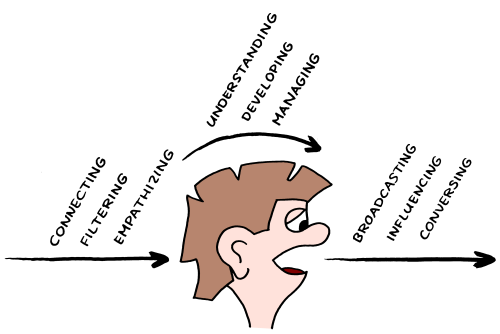In mathematics and sociology a small-world network is a system in which all agents can…
The 9 Capabilities of Communicators
Based on our earlier observation of what communication really means, with signals traveling from one mind to another, and overcoming many obstacles on the way, I want to offer a new way of distinguishing communicators in an organization. It is an approach that doesn’t categorize people in three groups, but instead it differentiates between people’s capabilities:
Connecting
Some people are good at making connections with other people. They create many pathways through which communication can potentially take place. Such people may have many friends on Facebook or LinkedIn; they frequently attend meetings and conferences; and in the office they know just about everybody.
Filtering
Knowing many people doesn’t mean that you’re actually listening to all their messages. People who are good at filtering not only actively listen to other people’s social network status updates, and hallway chatter, but they also know which people and messages to ignore. Someone who is well-connected can be bad at filtering qualitatively, while someone with only few connections could be listening more intently and selectively.
Empathizing
Actively listening to people still doesn’t mean that you care about what they are saying. There needs to be some emotional association to someone’s messages in order to feel interested. For example, a socially challenged system administrator could care more about what developers are saying than a social savvy project manager.
Understanding
And then there has to be a real understanding of what is being said. You may be enthusiastic about some architectural issue in your project, and I may be able to empathize with you, but if I don’t understand anything about architecture then I don’t know what you mean, and I cannot respond properly to what you’re telling me.
Developing
Given what you learn, and what you already know, you are able to develop new information, and then pass it along to others. Right now I am developing this list of capabilities by connecting the dots between the works of Cockburn, Stephenson, and Gladwell, while adding my own thoughts to the cocktail. The capability of people for developing (creating, building) new information seems to be overlooked in the other models.
Managing
Some people are good at managing (categorizing and evaluating) existing information. They know what is important and what not, and they know to whom they should communicate something and, at least as important, to whom they should not communicate something.
Broadcasting
Then there are people who are experts at radiating information, whether intentional or not. They give away all they know, to anyone they meet, with either positive or negative consequences. Whether it is about projects, customers, management, or personal relationships, these people can, and will, tell you all about it.
Influencing
But those who send a lot of information may not necessarily be good at also influencing their colleagues. The silent but brilliant software architect, who rarely says a word, may be the best person in the organization, when he talks, to really make a difference. Such people transmit messages to fewer people, but (because of their status or power) they have a much higher success rate of convincing them.
Conversing
Finally, influencers are not necessarily communicators. I am told that some of my blog posts have influenced people, but I have not directly exchanged ideas with many of my readers. This means that I am incapable of steering their actions, and there is no understanding of what they do with the information that I gave them.
These are the nine capabilities of communicators in a social network. I think it is more realistic to view a social network as a system of people who communicate with various capability levels in each of these nine areas. These capabilities change over time for each person, and probably fluctuate depending on their areas of interest. This turns the social network into the complex system that it really deserves to be.
(image by The U.S. Army)
This article will be part of the book Management 3.0: Leading Agile Developers, Developing Agile Leaders. You can follow its progress here.
 Twitter –
Twitter –  Subscribe –
Subscribe –  Newsletter –
Newsletter –  LinkedIn –
LinkedIn –  SlideShare
SlideShare
| Latest, greatest and favoritest posts: It’s Only Communication When There’s Verification Yes, Good Managers Are Manipulators Why We Delegate: The Darkness Principle |





